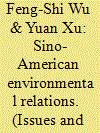| Srl | Item |
| 1 |
ID:
124074


|
|
|
|
|
| Publication |
2013.
|
| Summary/Abstract |
This paper applies two dimensions, inter-governmental and trans-societal, to discuss US-China environmental relations. It argues that, while official bilateral environmental relations between the two over the past 15 years have not yet achieved substantial outcomes, trans-societal linkages between American and Chinese NGOs and activists have grown steadily. The scope and volume of their work may not be as visible as that of ODA projects or official initiatives, but their impact may be more sustainable and not easily interrupted by administrative or regime shifts in either country. On the other hand, this paper highlights that US-China relations in regard to climate change will explain the main trends that will dominate the overall environmental cooperation in the coming years. Whether or not the governments can build up mutual trust and effective mechanisms in security, trade and other policy fields will affect the possibility of a conducive atmosphere for cooperation in environmental protection.
|
|
|
|
|
|
|
|
|
|
|
|
|
|
|
|
| 2 |
ID:
117343


|
|
|
|
|
| Publication |
2013.
|
| Summary/Abstract |
Goals on absolute emissions and intensity play key roles in CO2 mitigation. However, like cap-and-trade policies with price uncertainty, they suffer from significant uncertainty in abatement costs. This article examines whether an indicator could be established to complement CO2 mitigation goals and help reduce cost uncertainty with a particular focus on China. Performance indicators on CO2 emissions per unit of energy consumption could satisfy three criteria: compared with the mitigation goals, (i) they are more closely associated with active mitigation efforts and (ii) their baselines have more stable projections from historical trajectories. (iii) Their abatement costs are generally higher than other mitigation methods, particularly energy efficiency and conservation. Performance indicators could be used in the following way: if a CO2 goal on absolute emissions or intensity is attained, the performance indicator should still reach a lower threshold as a cost floor. If the goal cannot be attained, an upper performance threshold should be achieved as a cost ceiling. The narrower cost uncertainty may encourage wider and greater mitigation efforts.
|
|
|
|
|
|
|
|
|
|
|
|
|
|
|
|